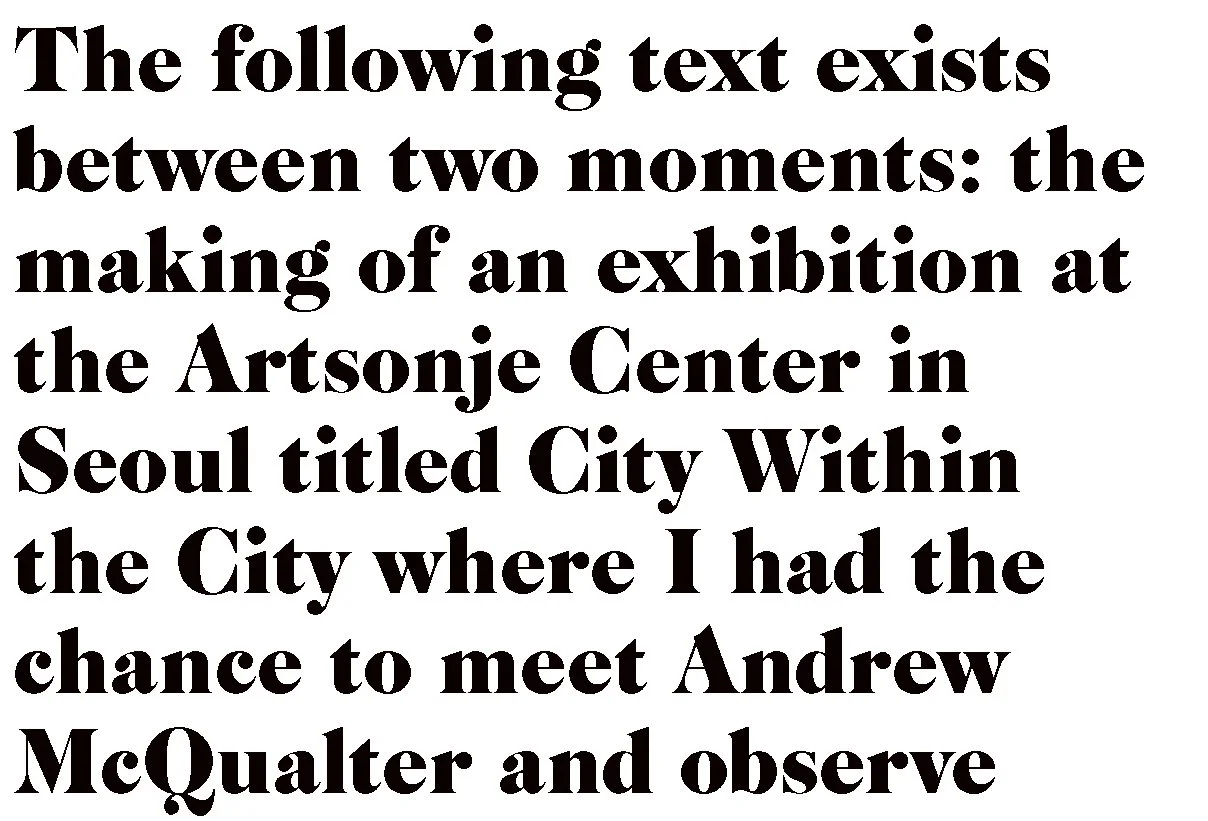Drawing from A partial index...
Projections can start out as one thing and end up as something else
Claudia Pestana
The following text exists between two moments: the making of an exhibition at the Artsonje Center in Seoul titled City Within the City where I had the chance to meet Andrew McQualter and observe him working on his wall drawing, and the present exhibition where he will continue to build on this process. It begins with my insights into the former exhibition's development and attempts to initiate an open-ended conversation on this work that bridges what was witnessed as the background behind a previous realisation of the work with what may be constructed from how it has emerged in the current show.
The City Within the City exhibition began as a conversation on cities in relation to urbanism and landscape. Addressing these topics often becomes about adopting a clearly demarcated position, be it through discussions regarding urban development, the meaning of progress, or concerns on how heritage is defined and preserved. However, attempts at determining specific problems and offering solutions to them sometimes remain solely at the level of discourse and often neglect a city's multitude of inhabitants with their diverse lived experiences. These inhabitants constitute a fabric of complexity upon which cities and the issues that characterise them are woven; yet this fabric is not easily made visible. Attempting to make this type of fabric visible by responding to agglomerations of the different works informed the development of City Within the City as a process that resulted in unravelling concepts rather than formulating consensual statements.
Within this framework, contact with Andrew McQualter's work initially occurred through descriptions and references to other works, a list of readings that ranged from philosophy to literary fiction, and finally by meeting him and inhabiting the exhibition space at the same time he was creating the wall drawing. Aware that the process would involve projecting images of figures and arranging them within the given space of the wall, it was surprising to notice that most of the figures where working together to realize some unknown idea in the abstract space of the drawing. Intriguingly, rather than vignettes of the structures that regulate how cities function or the people that inhabit them, most of McQualter's figures were engaged in activities potentially related to exhibition-making, like measuring out distances or setting up objects. Discretely observing the progression of the wall drawing, it was uncanny to witness how it simultaneously reflected the progress of the City within the City exhibition. Over time, different elements were projected onto the wall and as they were clustered together they redefined territories that in turn caused previous elements to be re-defined and re-arranged. All this occurred alongside the transformations in the space brought on by the other works being installed. Eventually the outcome could no longer be reduced to one description of how it had been developed. Yes, specific figures could be identified and associated to a particular place or moment, but they mainly operated as abstract references to a moment of engagement between two people, or a person and a specific action and it's consequences.
Realizing how A partial index, like a city or exhibition, is not the mere execution of a preconceived notion 'projected on to a blank wall' reveals the complexity and vulnerability inherent to McQualter's process. McQualter has described this process as one where he "'tells' of a work that, in a Platonic sense, exists elsewhere in an ideal form" and as he does this, he is also remaking this 'ideal text' in both his mind and the mind of the person engaging with his 'account' of it. When I consider this idea of re-telling something between two people I think of an image of another work: titled A form made by... it is described as 'a form made by constructing a coiled pot in the space between Geoff and me.' In the same way that this object made of coiled lines of clay gives visible form to the space existent between two people, the landscape that makes up A partial index also makes the fabric upon which ideas are negotiated and reconfigured visible.
- Claudia Pestana, 2012
A curator currently based in Sharjah, UAE, Claudia Pestana previously worked in Seoul, Republic of Korea first at the Nam June Paik Art Center from 2008 to 2010 and later at SAMUSO: Space for Contemporary Art from 2010 to 2011. Supported by a Calouste Gulbenkian Foundation Grant, Pestana received a Curating Contemporary Art MA from the Royal College of Art, London (2007).
View the exhibition >>

